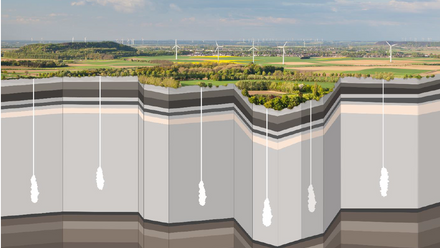From lab to grid: Dr Lizzie Ashton and Dr Jonathan Wilson answer your #BurningQuestions on hydrogen


In this edition of #BurningQuestions, Dr Lizzie Ashton and Dr Jonathan Wilson from Loughborough University share their insights on everything from blue hydrogen to skills, scaling, and the role hydrogen could play in transport and heating. Drawing on their work in materials chemistry, systems engineering, and hydrogen innovation projects in the UK and abroad, they explore how to ensure hydrogen technologies deliver real-world impact and what needs to happen next to keep the momentum going.
Q: Is the scale of investment in blue hydrogen diverting critical time, research, and capital away from the development and deployment of green hydrogen?
Lizzie: Not necessarily. Green hydrogen is the ultimate goal, but it won’t scale quickly enough on its own to meet net-zero by 2050. It’s still costly, and key materials like electrolyser catalysts are limited. Blue hydrogen helps reduce emissions in the short term using existing infrastructure, giving us time to scale up green alternatives.
Turquoise hydrogen also has real potential. It produces hydrogen and solid carbon through methane pyrolysis, avoiding CO₂ emissions. It can use current gas pipelines, which makes it easier to deploy. In economic analysis I’ve done comparing low-carbon hydrogen pathways, turquoise hydrogen even showed potential to be more cost-effective than blue, especially when accounting for carbon handling and infrastructure costs.
The important thing is to ensure these transitional options support the growth of green hydrogen, instead of delaying. They should help build the bridge, not become the destination.
Jonathan: Where green hydrogen is the gold star for a renewable energy vector; blue hydrogen is here now. We currently face a chicken and egg scenario where we are developing hydrogen production facilities without an immediate consumer and simultaneously developing hydrogen products that do not yet have a ready fuel source. Blue hydrogen is an important link to help us tie this together and create a new hydrogen economy.
Q: Which countries or regions do you believe are setting the best example for accelerating hydrogen adoption, and what are they doing differently that others could learn from?
Lizzie: Germany is a clear leader—strong regulatory frameworks and infrastructure investment. Japan also for its fuel-cell technology. Recently, I visited South Korea, specifically the Chungcheongnam-do province, which has impressive electrolyser infrastructure. The key thing we can learn is how they bring together clear policies, focused funding, and infrastructure.
Q: If hydrogen continues to gain traction in the future energy space, which skills or technical backgrounds do you think will become increasingly valuable?
Lizzie: Materials chemistry (I may be biased), chemical and systems engineering are key, alongside adapting existing expertise from the natural gas industry. It’s a natural evolution in skillsets, particularly around infrastructure and safety.
Jonathan: We are building a technical skill base in the UK with Engineers, Chemists, Physicists etc all working to produce a technological Hydrogen solution for the UK energy needs. Our next step is the jump to commercialisation which requires a new set of unique skills from business planning, distribution, manufacturing, servicing, customer integration and service. The industry will be expanding over the next decade and require skills from a wide and diverse set of professionals.
Q: With your background in systems engineering and clean hydrogen projects like MESCH, what do you see as the biggest technical barrier to scaling up off-grid hydrogen solutions here in the UK?
Lizzie: The main challenges are managing pressurised systems and ensuring materials are compatible and safe. Safety auditing plays a big part in this. Cost-effectiveness and recyclability are also important, which is why simpler solutions like lead-acid battery electrolysers make sense—they’re affordable, proven, and 99 % recyclable.
Jonathan: Transitioning from prototype to reliable deployment is standardisation. Hydrogen technologies have so far been developed in specialist industrial contexts, but we’re now asking them to operate in far broader markets—rural, domestic, off-grid. That shift needs clear technical standards that ensure interoperability, safety, and critically ease of installation across use cases.
Without standardisation, each deployment becomes a bespoke engineering project, which slows down scale-up and drastically increases cost.
Q: What kind of role do you think hydrogen could play in transport and heating by 2040—and how should engineers like us prepare now for that shift?
Lizzie: By 2040, I think hydrogen will have a key role in areas where switching to electricity isn’t straightforward, like heavy-duty transport, aviation, shipping, and heating in remote or off-grid places. These are all sectors where batteries might fall short, especially when it comes to energy density and quick refuelling.
To get ready for that shift, engineers like us need to start laying the groundwork now. That means developing the right infrastructure for hydrogen production, storage, and distribution, and making sure we have the skills to design and work with these systems safely. It’s not just about the technology; we also need to understand the practical challenges of using hydrogen at scale. Preparing now gives us the chance to shape how this transition happens, rather than just reacting to it later.
Jonathan: I believe hydrogen will play only a limited role in domestic vehicular transport. The energy density of compressed hydrogen is relatively low, the UK currently lacks any meaningful refuelling infrastructure, and battery-electric technologies are becoming increasingly efficient, affordable, and widespread. In contrast, hydrogen has a much stronger case in heavy-duty and passenger transport—sectors like buses, rail, and even HGVs—where return-to-base refuelling strategies make hydrogen practical and cost-effective. We’re already seeing strong uptake in these areas.
For heating, the opportunity is far greater. The UK consumes over 60 billion cubic metres of natural gas annually—so even replacing a small percentage of that with green hydrogen would lead to significant carbon savings. Domestic heating is rightly a major focus for UK hydrogen development. Projects are already trialling low-level hydrogen injection into the national gas grid, with expectations that blends of up to 20% could become standard in the coming years.
Engineers should prepare by understanding the constraints and requirements of grid blending, burner compatibility, retrofit potential, and safety standards. The shift to hydrogen heating won’t be wholesale overnight—but supporting that incremental, systems-based transition is where a lot of our technical focus will be needed.
Q: There’s a lot of talk about hydrogen innovation, but how do we make sure these technologies, like ACCT or modular systems, transition from prototype to reliable deployment without losing momentum or funding?
Lizzie: Maintain clear regulatory support, ensure consistent funding, and actively involve industry partners early in development phases. Technologies need real-world demonstrations to maintain momentum.
Jonathan: I’ve had the opportunity to develop several novel technologies through to commercial readiness, and I can say with confidence—it’s a multifaceted challenge. For a technology to succeed, it needs to align with a real market need, at the right time, with the right funding available. In the UK, there’s a well-known gap between TRL 3 and TRL 5—that critical phase where concepts leave the lab but aren’t yet ready for pilot deployment. It’s here that many promising technologies stall, losing either momentum or financial backing.
To overcome this, we need more targeted support across the whole innovation pipeline—not just early-stage research or late-stage commercialisation. That includes funding mechanisms specifically designed to support prototype refinement and in-field trials. But just as importantly, we need strong, early partnerships with industry. Providing test beds and routes to market gives novel technologies the real-world feedback and iterative development they need to scale successfully.
Q: Your work in Africa is really interesting—what lessons from those hydrogen and microgrid deployments could be applied to hard-to-reach communities or decarbonisation efforts here in the UK?
Lizzie: In Africa, microgrids are built to be flexible and easy to scale. That kind of modular setup could really help in the UK, especially with managing wind power. It means we can quickly respond to changes in supply and demand, reduce curtailment, and make much better use of our renewables.
Jonathan: One of the key challenges we face is that renewable generation and energy demand are often not co-located. In the UK, we’re generating vast amounts of clean electricity—particularly from wind—but we’re struggling to move that energy to where it’s needed, due to limitations in grid capacity, storage, and responsiveness to demand. On some days, we curtail over 125 GWh of wind power—enough to power the UK for around four hours—simply because there’s nowhere for it to go.
This is where the lessons from off-grid systems in Africa become highly relevant. In those contexts, we’ve had to develop low-cost, modular, and easy-to-deploy solutions—battery-electrolyser hybrids that can be placed where the energy is, not just where the people are. These systems act as buffers, soaking up excess renewable generation and storing it as hydrogen for later use. The same principle could be a game-changer for the UK: co-locating storage with generation assets in constrained areas and turning curtailment into opportunity.
Q: What’s next for you? Are there any areas of hydrogen systems or clean energy integration you’re particularly keen to explore over the next few years?
Lizzie: I’d like to see a battery-electrolyser systems on a wind farm in the UK. Using excess wind power to produce hydrogen could make the grid more flexible and reduce wasted energy. Wind curtailment current costs the £1.5 billion per year!
From a materials perspective, I’m continuing my research into solid-state hydrogen storage, particularly using lightweight metal hydrides. These materials have a lot of potential for mobile applications where high energy density and compact, safe storage are essential. There's still a lot we don't fully understand, and I’m excited to dig deeper into how we can tune these systems to perform better.
I'm also continuing research into the use of lead-acid batteries as low-cost electrolysers by going back to the fundamentals. These batteries were originally designed to suppress gas evolution, but I believe there's real value in re-examining the reaction pathways and kinetics. By understanding these mechanisms more deeply, we could tailor the electrode materials to enhance hydrogen production efficiency, while still maintaining the battery’s original function. It’s a largely underexplored area, and I think it has the potential to unlock some exciting new possibilities for low-cost, dual-purpose energy systems.
Jonathan: As an academic, one of my core goals is ensuring that research doesn’t just stay in the lab—it needs to create real-world impact. While I continue to explore fundamental questions and seek out the next big idea, I’m particularly focused on progressing our battery-electrolyser system to full commercial maturity. It’s a versatile, low-cost solution with real potential to support grid flexibility, reduce wind curtailment, and bring clean hydrogen into off-grid and constrained network environments.
Beyond the technical work, I’m also keen to use this experience and data to help shape UK policy on hydrogen—especially around deployment pathways and infrastructure support. Bridging the gap between academic research, industry readiness, and policy design.
NEXT UP: Green gas with Charles McAllister
(Submit your questions by 15 July)


![gas pipeline [freepik]](https://www.igem.org.uk/static/ccb55261-d0c9-4f41-9f0056034d9abbfb/resourcegridlistingimagedefault_4d12532919c64e60a22baf03232bbf94_4a7c7e45a350/gas-pipeline-freepik.png)
![tractor[freepik]](https://www.igem.org.uk/static/9825f804-d13f-4d45-b8b7aa0239eec116/resourcegridlistingimagedefault_4d12532919c64e60a22baf03232bbf94_4a7c7e45a350/tractorfreepik.png)
![hydrogen truck [canva]](https://www.igem.org.uk/static/101e9204-77f7-4fb2-86c414acf6c1ab81/resourcegridlistingimagedefault_4d12532919c64e60a22baf03232bbf94_4a7c7e45a350/hydrogen-truck-canva.png)
![hydrogen particles [canva]s](https://www.igem.org.uk/static/d8934dcf-ba26-463f-91c8788b56b9fba0/resourcegridlistingimagedefault_4d12532919c64e60a22baf03232bbf94_4a7c7e45a350/hydrogen-particles-canvas.png)
![Steel [canva]](https://www.igem.org.uk/static/50be7f75-c475-4a0a-9980bc2553030d23/resourcegridlistingimagedefault_4d12532919c64e60a22baf03232bbf94_4a7c7e45a350/Steel-canva.png)
